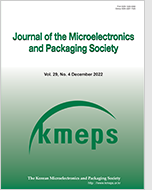
Search
- Past Issues
- e-Submission
-

KCI Accredited Journals KCI 등재지
KCI Impact Factor 0.54
Editorial Office
- +82-2-538-0962
- +82-2-538-0963
- kmeps@kmeps.or.kr
- http://kmeps.or.kr/

KCI Accredited Journals KCI 등재지
KCI Impact Factor 0.54
Journal of the Microelectronics and Packaging Society 2024;31(4):71-75. Published online: Jan, 22, 2025
DOI : doi.org/10.6117/kmeps.2024.31.4.071
Semiconductor packaging technology has advanced in response to the increasing demands for high performance and miniaturization of electronic devices. Wire bonding and bump interconnection methods can detect defects during X-ray inspections in highly integrated semiconductor chips. However, inspection methods using CT scans result in longer scanning times, reducing productivity, and the increased radiation dose can lead to additional defects in the semiconductor chips. To address these issues, this study proposes a preprocessing method that combines deep learning networks, Fourier transform, and machine learning-based optimization techniques. The aim is to improve defect detection in semiconductor chips by removing background information that is not interesting from 2D X-ray projection images. The phantom data for the semiconductor chips was generated using MATLAB, and projection images were acquired using a GPU-based Geant4 simulator (GGEMS). Our proposed method effectively removed the background of semiconductor chip projection images while preserving critical details.
Keywords Semiconductor packaging, X-ray, Deep learning, Optimization